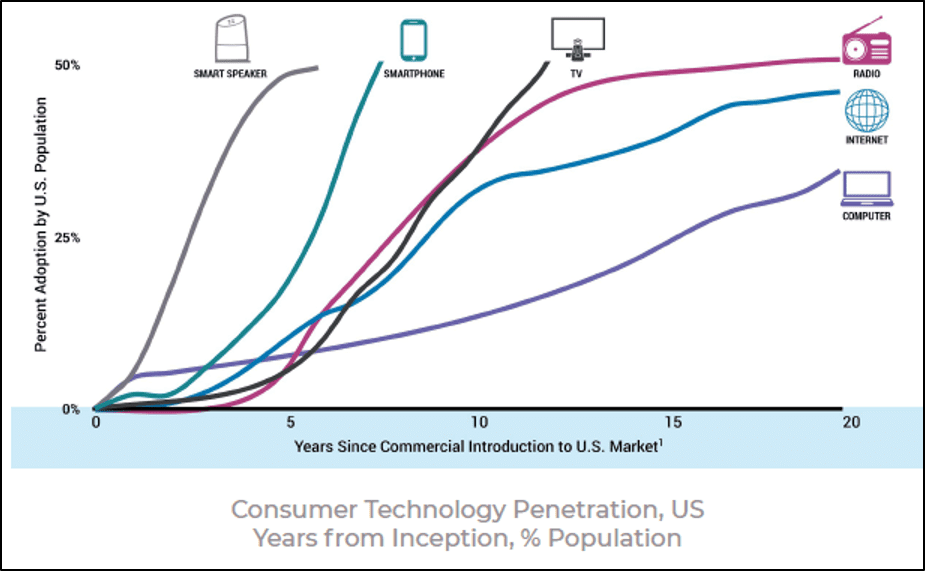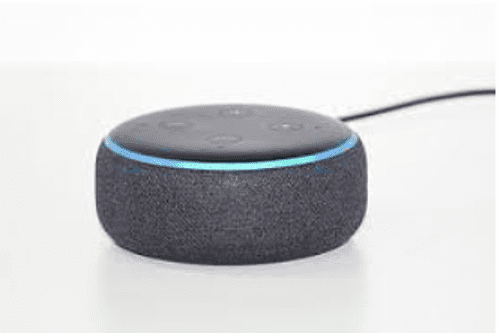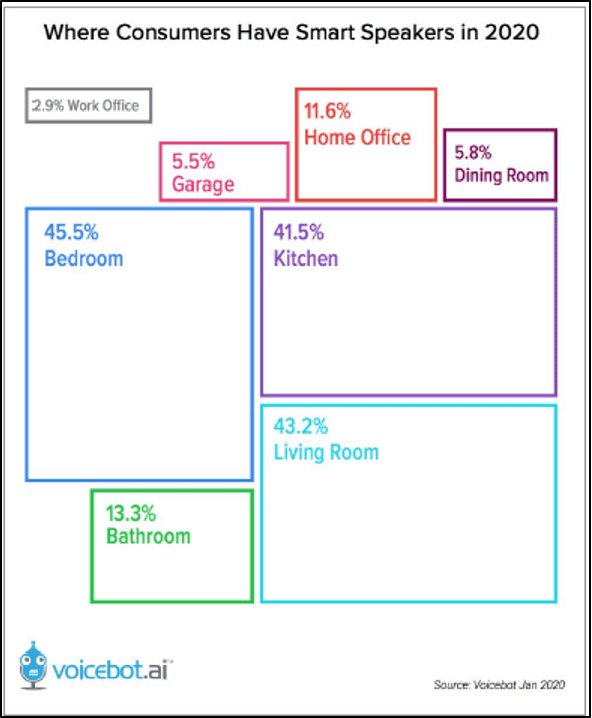Voice technology is taking the world by storm, with no signs of slowing down. Smart speaker adoption is faster than any other consumer technology, and smart speaker use is projected to rise to 55% by 2022.
The rising trend in smart speaker use provides a window of opportunity for companies to establish a brand presence and amplify cross-channel marketing efforts. And Davida Gaffney, an Email/Web Developer at StorageMart, knows this from firsthand experience.
During our inaugural virtual Activate Live conference, she discussed three ways you can integrate voice into your cross-channel messages and gain a competitive edge.
Don’t worry—you don’t need coding skills for this because building a brand presence is easier and more accessible than you think.
Curious to know how you can leverage voice in your cross-channel marketing? Then keep reading!
About StorageMart
Headquartered in Columbia, Missouri, StorageMart is the largest privately-held, self-storage company in the world, offering convenient storage solutions throughout the U.S., Canada, and the U.K.
Davida, who supports a modest in-house marketing department, encounters challenges that accompany smaller teams. But trying new things (and bringing innovative solutions to the forefront) isn’t one of them.
In this case, Davida’s passion for innovative marketing solutions inspired her to create the company’s first voice application and use it to provide basic information, generate leads, and create a better customer experience.
We’ll later discuss the steps Davida took to build StorageMart’s first voice application. But first, let’s talk about the difference between voice applications and voice assistants and the benefits of leveraging voice technology.
Why Use Voice Technology?
Voice applications vs. voice assistants
People often use the terms “voice applications” and “voice assistants” interchangeably. However, it’s important to distinguish between the two, so you can better understand what each entails.
Voice applications are speech-based interactions and capabilities set forth by the brand. As the name suggests, they rely on voice-based inquiries to process information and provide the right answers. Like mobile apps, you can enable or disable them on the device.
Currently, there are three major platforms for which to develop consumer-facing voice applications: Amazon, Google and Samsung. While the fundamentals of voice design remain the same across these platforms, each has its own way of naming and building its application. (Note that Apple doesn’t support third-party voice development capabilities at present.)
On the other hand, voice assistants are a type of voice application used through a voice user interface (VUI). They’re the conduit for conveying information and executing commands. Unlike voice applications, voice assistants have unique personalities and characteristics that drive the overall voice experience for consumers across devices.
| Platform | Amazon | Samsung | |
| Voice Application | Skills | Actions | Capsules |
| Voice Assistant | Alexa | Google Assistant | Bixby |
Now that you know the difference between the two, let’s move onto why you should take advantage of voice technology.
Three Main Benefits of Voice Technology
Benefit 1: Adoption
We mentioned earlier that smart speaker adoption is faster than any other consumer device, including the radio, TV, computer, and smartphone. It took approximately five years for smart speakers to reach 50% adoption rate, whereas it took an average of roughly 13 years for the other devices to arrive at the same rate.
Given this, it would behoove brands to capitalize on voice to achieve their marketing goals.


Source: U.S. Census Bureau World Bank
Benefit 2: Authority
With voice, you have the chance to build your brand authority and make your brand the go-to data source for answers. For example, Alexa searches Skills before searching the web. Should your brand decide to go with Skills, you can create a robust knowledge base from which your users can access with a simple voice command.


Alexa (or any other voice assistant) can catapult your brand authority.
Benefit 3: Customer Experience
Using voice provides an immersive experience for your customers since it’s fully integrated into their homes, cars, and lives. Whether they’re working in the home office or watching TV in the living room, they can engage with your brand more conveniently and with less friction.
What’s more, voice technology lets you discover potential use cases and use them to address your customers’ concerns in the future.


Source: Voicebot.ai
Now that you know why you should use voice technology, let’s talk about what tool you can use to build your first voice application.
Tools to Use
A good starting point is Voiceflow, a drag-and-drop tool that lets you build cross-channel communication workflows for Amazon Alexa and Google Assistant. Here’s a list of some of its perks, according to Davida:
- It has great usability with pre-built integrations and custom coding functionalities.
- There’s an active user community for hands-on support.
- There’s solid documentation for you to reference at any time.
- There are lots of templates to choose from.
- It’s free!
Once you create the workflow, you can use it to trigger a custom event on an Iterable campaign, ensuring a seamless experience for your customers.
Pro tip: If you’re using Iterable’s Catalog, your catalog (say, of store locations) can easily be referenced when interacting with a voice application, providing information to customers about your products or services (such as store hours, contact information, amenities and more).
With this in mind, here are three easy ways you can incorporate voice to strengthen your cross-channel messages.
3 Steps to Building Your Voice Application
With Davida’s experiment with Alexa, she applied the following steps to build StorageMart’s first voice application, and you can too if you heed her advice.
Step 1: Inform
Your goal here is to establish a brand presence and put some basic brand information on the voice channel. For instance, Davida provided answers to these three questions:
- Can I live in a storage unit?
- What sets StorageMart apart from the competition?
- Can I book short-term storage?
Your company’s FAQ is a good entry point since the information you need is readily available.
Step 2: Extend
Enrich your customers’ experience by expanding on existing content, adding new information, and building out views and channels. Figure out which additional resources you can access to deliver more relevant, value-driven content.
Regardless of what you choose, be sure to make the responses sound more natural and conversational.
Step 3: Transact
Your ultimate goal is to achieve conversions and ROIs with relevant CTAs, and connecting the voice experience to backend databases can help you get there. For example, Davida built her Alexa Skills to collect customer information for a phone call follow-up if the customer didn’t find answers from the FAQ, which allowed her to generate leads.
It is also at this step where collaboration with your technical teams plays a major role. Davida partnered with Shawn Twenter, IT Manager at StorageMart, to build and troubleshoot these voice technologies, as well as attend voice-related conferences and hackathons to develop their skills. Forging a partnership like theirs can bring immense value to your cross-channel marketing program and ultimately drive its success.
So far, we talked about the difference between voice applications and voice assistants. We also discussed the ‘what,’ the ‘why,’ and the ‘how’ of voice applications.
Next: we’ll talk about the pros and cons of voice technology and provide an example of how you can combine the power of voice with your cross-channel marketing.
Cross-Channel Opportunity
Based on the examples we shared earlier, you’ve probably gleaned that voice gives you the flexibility to go hands and sight-free and intuitively engage in a 1:1 conversation, thanks to its natural and low learning curve.
However, like many technological innovations, voice applications aren’t perfect. The sensitive nature of this channel renders it unconducive to public use or during quiet time, whereas other channels allow users to engage with their device more covertly. Also, using voice isn’t the best way to retain reference information for future use.
Another drawback is that voice applications are user-dependent, so if people don’t engage with them frequently enough or don’t know how to derive value from them, then all that work will be for naught.
The good news?
You can incite action (and fulfill your marketing goals) by finding the appropriate channel for each task. For illustration, check out this cross-channel workflow from StorageMart below.


In this use case, StorageMart customers can give simple voice commands to pay their bills.
Of course, there are multiple ways to incorporate voice, but the key is to understand how the voice channel fits into your overall campaign and make the experience as seamless as possible.
Need more ideas? Brainstorm with your team and come up with a few workflows based on some of your goals.
Be Seen and Heard With Voice Technology
Voice technology is a force to be reckoned with. What was once considered a ‘nice-to-have’ is quickly becoming a ‘must-have,’ and when used correctly, it can help your brand stand out in the crowd.
While you don’t need technical prowess to jumpstart your voice journey, a friendly chat with one of our Iterable team members might be what you need to pave a pathway for success.
Go ahead. Request a demo today!































